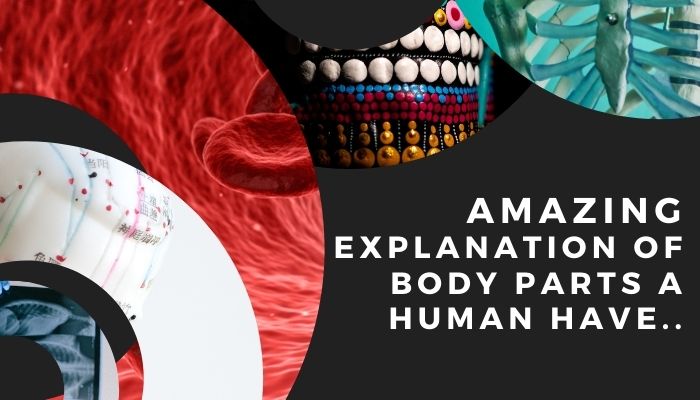Amazing Explanation of Body Parts a Human Have
Why do we have various body parts? Why they are necessary? What are responsibility they play to keep you live? Let's unleash the Science Secrets...

Heart - Your body’s engine, the heart pumps blood to every cell in the body.
Blood - A mix of special cells and liquid plasma, blood delivers all the good stuff(oxygen, vitamins, minerals and chemicals called hormones) to the cells in your body and carries away all the bad stuff(carbon dioxide and the other waste) for disposal. Red blood cells transport oxygen, while the white blood cells fight infection. Special cells called platelets seal the leak when the blood vessels break -- a process called clotting. An oxygen carrying protein called hemoglobin is what gives blood its red color.
Lungs - Each breathe you inhale fills these balloons like organs with oxygen, which is absorbed into your blood; each exhalation expels carbon dioxide waste from your blood.
Skin - Skin holds your insides in and protects your tissues from ultra violet radiations from the outside. Skin is your body’s largest organ. It is made of layers of cells that march to the surface and flake off from friction. The outermost layer is entirely dead.
Tonsils - These two meatball-shaped masses of tissues at the back of your throat are part of your lymph system, which includes a network of nodes that work like little security guards to battle infection.
Appendix - This skinny tube in our digestive system is mostly useless today and can actually endanger your life if it becomes inflamed. Scientists suspect that the appendix, which replenishes essential bacteria in our guts, was an important organ back before germ-fighting medicines helped humans overcome constant bouts of diarrhea.
Stomach - This expandable organ stores every-thing you eat and starts breaking down food with powerful acids.
Intestines - The bulk of food digestion takes place in your small and large intestines, two tubes that absorb all the vitamins, minerals, and other nutrients from everything you eat.
Liver - Your body’s biggest internal organ, the liver is like a complex chemical-processing plant. It converts nutrients from the small intestine into fuel your body can use. It makes bile, an essential substance for digestion. It cleans your body of toxins and removes damaged red cells.
Kidneys - This bean-shaped organ is so essential to good health that your body comes with a second one for free. Each kidney is crammed with more than a million microscopic filters -- called nephrons -- that skim the waste chemicals and other gunk from your blood.
Pancreas - This organ injects special protein substances called enzymes into your small intestine to break down carbohydrates for fats, energy, and proteins for body-building materials. The pancreas also creates a crucial hormone called insulin, which regulates the levels of sugar in your body.
Spleen - This fragile fist-shaped sack is your body’s infection fighter, filtering bacteria, viruses, and other nasty invaders from your blood.
Skeleton - Remove all your bones -- along with the joints and muscles pinned to them -- and you’d end up a shapeless, motionless bag of your blood and organs. Your skull and spinal vertebrae, made of tough deposits of calcium and other minerals, are like armor for your brain and nervous system. Special bone marrow in your vertebrae and elsewhere is your body’s blood factory. Your muscles and joints, meanwhile, set your human machine in motion.
| 350 | About the number of bones in the body at birth |
| 206 | Number of bones in an adult(many bones fuses together during growth) |
| 20 Feet(6M) | Length of small intestine |
| 60,000 Miles (96,560KM) | Length of bloof vessels |
| 1.3 Gallons(5L) | Average volume of blood in an adult's body |
